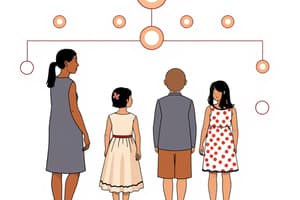Podcast
Questions and Answers
What does kinship primarily refer to?
What does kinship primarily refer to?
- Religious beliefs
- Political structures
- Social relationships (correct)
- Economic systems
Which of the following is a basis for kinship?
Which of the following is a basis for kinship?
- Political affiliation
- Rules and laws (correct)
- Geographic location
- Shared hobbies
What is one function of kinship?
What is one function of kinship?
- To provide continuity between generations (correct)
- To promote political ideologies
- To regulate artistic expression
- To establish trade routes
With what is the study of kinship concerned?
With what is the study of kinship concerned?
What is included in kinship relationships?
What is included in kinship relationships?
What is a decent group?
What is a decent group?
Which of the following is a function of decent groups?
Which of the following is a function of decent groups?
Which of the following is a principle of classifying kin?
Which of the following is a principle of classifying kin?
What are kin types?
What are kin types?
What is used to designate each individual relationship?
What is used to designate each individual relationship?
Which of the following is an example of a kin term?
Which of the following is an example of a kin term?
What does the kinship characteristic symbol of a circle usually represent?
What does the kinship characteristic symbol of a circle usually represent?
What does a horizontal line in kinship relationships usually represent?
What does a horizontal line in kinship relationships usually represent?
What does a vertical line in kinship relationships usually represent?
What does a vertical line in kinship relationships usually represent?
What does a double horizontal line represents in kinship relationships?
What does a double horizontal line represents in kinship relationships?
What does the term 'ego' refer to in a kinship diagram?
What does the term 'ego' refer to in a kinship diagram?
Which aspect of culture does kinship classification influence?
Which aspect of culture does kinship classification influence?
The family of orientation does what?
The family of orientation does what?
The family of procreation is what?
The family of procreation is what?
What is an extended family?
What is an extended family?
What is a nuclear family?
What is a nuclear family?
What is a step family?
What is a step family?
What is a single parent family?
What is a single parent family?
Flashcards
What is Kinship?
What is Kinship?
The web of social relationships that form an important part of the lives of all humans in all societies.
What is Kinship?
What is Kinship?
A sense of being related to another person(s). It can be set by rules (sometimes laws) and is often taken for granted as being “natural” rather than cultural
Kinship
Kinship
Includes relationships through blood and through marriage. It functions to provide continuity between generations and defines a group on whom a person can rely for aid.
What is a Decent Group?
What is a Decent Group?
Signup and view all the flashcards
Functions of Descent Groups?
Functions of Descent Groups?
Signup and view all the flashcards
Kin Types
Kin Types
Signup and view all the flashcards
Kin Types
Kin Types
Signup and view all the flashcards
Kin Terms
Kin Terms
Signup and view all the flashcards
Kin Terms
Kin Terms
Signup and view all the flashcards
Family of Orientation
Family of Orientation
Signup and view all the flashcards
Family of Procreation
Family of Procreation
Signup and view all the flashcards
Extended Family
Extended Family
Signup and view all the flashcards
Nuclear Family
Nuclear Family
Signup and view all the flashcards
Complex Family
Complex Family
Signup and view all the flashcards
Step Family
Step Family
Signup and view all the flashcards
Single Parent Family
Single Parent Family
Signup and view all the flashcards
Foster Family
Foster Family
Signup and view all the flashcards
Childless family
Childless family
Signup and view all the flashcards
Adopted family
Adopted family
Signup and view all the flashcards
Traditional family
Traditional family
Signup and view all the flashcards
Kinship Classification and Culture
Kinship Classification and Culture
Signup and view all the flashcards
What does kinship create?
What does kinship create?
Signup and view all the flashcards
What does the study of kinship involve?
What does the study of kinship involve?
Signup and view all the flashcards
Whats a kin term?
Whats a kin term?
Signup and view all the flashcards
Whats a kin type?
Whats a kin type?
Signup and view all the flashcards
Study Notes
- Kinship dynamics concerns itself with family structures and relationships.
- It is a web of social relationships vital to all humans in all societies.
Kinship Defined
- It involves a sense of relatedness to others.
- It is guided by rules, even laws, and is viewed as natural rather than cultural.
- Cultures have varying definitions of "blood relatives".
- Study of it entails the study of: mating, gestation, parenthood, socialization, and sibling relationships.
- It includes relationships formed through blood or marriage.
- It ensures generational continuity and defines groups for mutual aid.
Descent Groups Defined
- Descent groups are affiliations between parents and children.
- Descent groups organize domestic life, transfer property, enculturate children and settle disputes.
Principles of Classifying Kin
- Classifying kinship involves factors include: generation, relative age, gender, lineality, collaterality, consanguineal vs. affinal kin, sex of linking relative, and side of the family.
Kin Types vs. Kin Terms
- Kin types are the anthropological definitions of kinship categories and are culture-free (ETIC).
- Kin types are based on biological relationships, defining objective relationships.
- Kin terms are labels for kinship categories and are culture-specific (EMIC).
- In simpler terms, kin terms is how people address one another.
Kin Types
- A kin type designates each individual relationship such as: mother, father, and siblings.
- Each relationship between kin is described by a sequence of primary components showing biological relationships.
Kin Type Examples
- Mother = M
- Father = F
- Sister = Z
- Brother = B
- Daughter = D
- Son = S
- Husband = H
- Wife = W
- Mother's Sister = MZ
- Mother's Sister's Daughter = MZD
- Sister's Son = ZS
Kin Terms
- Kin terms are culture specific e.g. uncle, cousin, and grandfather are English terms that are not kin types if relationships include more than one
- Kin categories are not exclusive to biological relations.
English Kin Terms
- Father is F
- Uncle is FB, MB
- Brother is B
- Cousin is FBS, FBD, FZS, FZD MBS, MBD, MZS, MZD FFBSS, Etc.
- Son is S
- Nephew is BS, ZS
Kinship Characteristics (Symbols)
- Female: Circle
- Male: Triangle
- Deceased Female: Circle with an X
- Deceased Male: Triangle with an X
- Female "Ego": Solid Circle
- Male "Ego": Solid Triangle
- "Ego" is you, self, or reference point.
- Married to: =
- Cohabiting with: ≠
- Divorced from: a slashed ≠
- Separated from: a slashed =
- Adopted-in female: Circle with a smaller circle inside
- Adopted-in male: Triangle with a smaller triangle inside
- Is descended from: |
- Is the sibling of: ⅃
Lineal vs. Collateral Kin
- Provided is a visual chart of Lineal and Collateral Kin
Kinship Classification and Culture
- It outlines rights and obligations
- Specifies interpersonal conduct
- Determines the social groups formed and regulates marriage and inheritance.
Types of Family (based on)
- Based on birth: family of orientation and procreation
- Based on marriage: includes monogamous, polygynous, and polyandrous
- Based on residence: includes matrilocal, patrilocal, and changing residence.
- Based on ancestry: includes matrilineal and patrilineal ancestry
- Based on relation: relations include conjugal or consanguine
- Based on authority: authority is matriarchal or patriarchal
- Based on of size or structure: structures are nuclear, joint, or extended
Family of Orientation
- This orients one to the world and imparts knowledge of how family functions.
Family of Procreation
- This is a family you create as you become an adult.
Additional Family Structures
- Extended family: Close relatives live together, sharing responsibilities and expenses.
- Procreation family: Where an individual sets up after marriage and begins living with in-laws.
- Nuclear family: A small group consisting of a husband, wife, and children (natural or adopted).
- Complex family: An extended family that includes three or more adult members living together with their children.
- Step family: Adults who have separated and remarried, bringing children together to form a new nuclear group.
- Single parent family: Consists of one parent and their children.
- Foster family: One or more parents provide temporary guardianship for one or more children.
- Childless family: A couple with no children.
- Adopted family: A couple adopts a child with whom they share no genetic relation. Traditional family: The father is the financial provider, and the mother takes care of the family.
Studying That Suits You
Use AI to generate personalized quizzes and flashcards to suit your learning preferences.




